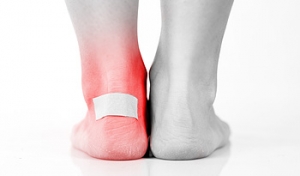Items filtered by date: January 2018
Blisters on the Feet
Blisters are a common ailment of people who wear shoes that are either too tight or rub against the feet in an uncomfortable way. Knowing the basics of blisters is important for understanding how they are formed and what treatments should be used for them.
A blister on the foot, or any other part of the body, is a small pocket that is filled with fluid. It usually forms on the upper layer of the skin because these layers are loose enough to allow a blister to form. The most common fluid in a blister is just a clear, watery-like fluid that usually isn’t cause for concern. However, blisters can fill up with blood if they are deep enough and pus if they have become infected with bacteria.
Blisters almost always form on the feet due to shoes rubbing up against the foot, where the friction causes blisters. These can occur after you have walked for a long period of time or when your shoes do not fit you properly. Your feet are also more prone to blisters if they are moist, so keeping them dry and clean is one preventative step you can take.
Preventing infection should be the number one concern when treating blisters, as well as relieving the pain they can cause. Using a bandage to cover up the blister will help it heal and prevent bacteria from entering it. New skin will form under the blister and eventually cause it to pop. You can also take a sterilized pin and try to pop it yourself.
If the blister is filled with pus or blood, seeking treatment from a doctor is ideal. Antibiotics may need to be taken in order to completely eliminate the bacteria inside the blister. See a doctor to have an antibiotic prescribed.
The best way to treat blisters is to prevent them all together. Keeping your feet dry and making sure that your shoes fit properly are just two of the steps you can take to prevent blisters. Shoes that are too tight or shoes that are too loose and allow your feet to slide in them will cause blisters. Applying a bandage to an area where you think a blister is about to form is another way you can prevent them.
Why Do I Have Blisters On My Feet?
 Friction is generally the leading cause of blisters occurring on the feet. The majority of them are filled with a clear fluid; however, if an infection occurs, it may appear to have a yellowish hue. Typically, wearing ill-fitting shoes may cause friction on the skin, usually developing during repetitive motions like running and walking at moderate speeds. Some other causes of blisters may originate from severe burns or tissue damage caused by frostbite, while certain medical conditions including eczema can be linked to blisters on the feet. Treatment may include wearing shoes that fit comfortably without having the toes rub together. You can also apply a gauze pad for protection. If this option is chosen, infection may be avoided by changing the dressing regularly. Relief will be desired if extreme discomfort is experienced, and the blister may need to be drained. Please consider a consultation with a podiatrist for advice and recommendations for treatments of blisters.
Friction is generally the leading cause of blisters occurring on the feet. The majority of them are filled with a clear fluid; however, if an infection occurs, it may appear to have a yellowish hue. Typically, wearing ill-fitting shoes may cause friction on the skin, usually developing during repetitive motions like running and walking at moderate speeds. Some other causes of blisters may originate from severe burns or tissue damage caused by frostbite, while certain medical conditions including eczema can be linked to blisters on the feet. Treatment may include wearing shoes that fit comfortably without having the toes rub together. You can also apply a gauze pad for protection. If this option is chosen, infection may be avoided by changing the dressing regularly. Relief will be desired if extreme discomfort is experienced, and the blister may need to be drained. Please consider a consultation with a podiatrist for advice and recommendations for treatments of blisters.
Blisters are prone to making everyday activities extremely uncomfortable. If your feet are hurting, contact Dr. Kenneth Donovan of Advanced Care Foot and Ankle. Our doctor can provide the care you need to keep you pain-free and on your feet.
Foot Blisters
Foot blisters develop as a result of constantly wearing tight or ill-fitting footwear. This happens due to the constant rubbing from the shoe, which can often lead to pain.
What Are Foot Blisters?
A foot blister is a small fluid-filled pocket that forms on the upper-most layer of the skin. Blisters are filled with clear fluid and can lead to blood drainage or pus if the area becomes infected.
How Do Blisters Form?
Blisters on the feet are often the result of constant friction of skin and material, usually by shoe rubbing. Walking in sandals, boots, or shoes that don’t fit properly for long periods of time can result in a blister. Having consistent foot moisture and humidity can easily lead to blister formation.
Prevention & Treatment
It is important to properly care for the affected area in order to prevent infection and ease the pain. Do not lance the blister and use a Band-Aid to provide pain relief. Also, be sure to keep your feet dry and wear proper fitting shoes. If you see blood or pus in a blister, seek assistance from a podiatrist.
If you have any questions, please feel free to contact one of our offices located in Warren, Livingston, and Toms River, NJ . We offer the newest diagnostic and treatment technologies for all your foot care needs.

